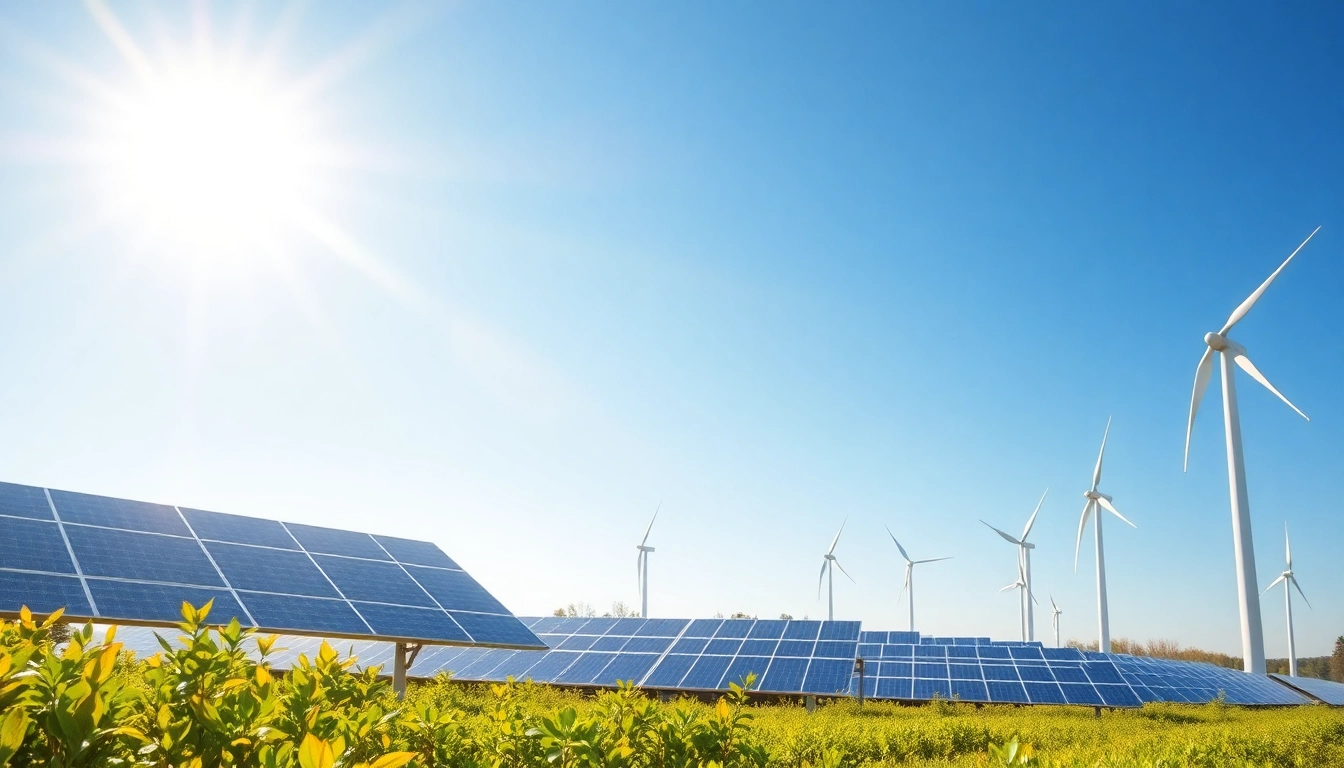Introduction to Renewable Energy in India
Renewable energy has emerged as a crucial pillar for sustainable development in India, given its vast geographical landscape and abundant natural resources. Defined as energy derived from natural sources that are replenished at a higher rate than they are consumed, renewable energy encompasses a variety of sources including solar, wind, hydropower, bioenergy, and emerging technologies such as green hydrogen. As the government, industry stakeholders, and international investors prioritize environmental sustainability, the role of renewable energy becomes increasingly vital to India’s energy security and climate commitments.
For those seeking an in-depth understanding of how renewable energy is transforming India’s power landscape, renewable energy continues to be a focal point due to its potential to meet nearly 40% of the nation’s power needs by 2030.
Current State and Growth Trajectory of the Renewable Energy Sector
Over the past decade, India has experienced exponential growth in its renewable energy capacity, driven by policy reforms, technological advances, and a sharp decline in generation costs. According to recent reports, India has achieved significant milestones, including surpassing 100 GW of solar capacity and 40 GW of wind energy installations. The sector’s growth is expected to accelerate further, with projections indicating that by 2030, the renewable energy share in the national grid could reach 40%, helping India cut its dependence on fossil fuels and significantly reduce carbon emissions.
Market data suggests a consistent rise in project tenders, technological innovation, and investments from global players. Notably, India’s renewable energy sector has attracted over USD 40 billion in investments in recent years, establishing it as one of the world’s fastest-growing markets. Cost competitiveness, combined with the federal and state-level policy environment, fosters a conducive ecosystem for renewable evolution.
Government Policies and Initiatives Fostering Renewable Energy Deployment
India’s renewable energy advancement is underpinned by a robust policy framework aimed at creating a supportive environment for project development and investments. The Ministry of New and Renewable Energy (MNRE) has implemented a series of ambitious targets and regulations, including the National Solar Mission aiming for 100 GW capacity by 2022 and further expansion plans beyond that horizon.
Noteworthy recent initiatives include the Central Green Open Access Rules, 2022, and state-specific mandates such as Rajasthan’s recent guidelines that advocate for Battery Energy Storage Systems (BESS) in open access projects exceeding 5 MW. Additionally, policies such as Virtual Power Purchase Agreements (VPPAs) — now greenlighted by the Central Electricity Regulatory Commission (CERC) — are instrumental in enabling flexible contracting mechanisms, boosting market liquidity, and attracting diversified investments in renewable projects.
Collaborative efforts with auto manufacturers, urban planners, and global lenders aim to fast-track renewable deployment, with significant focus on integrating renewables into power grids, enhancing storage solutions, and fostering innovation in clean energy technologies.
Types of Renewable Energy Sources and Technological Advances
Solar, Wind, Hydropower, and Emerging Technologies
India’s renewable portfolio is predominantly anchored in solar and wind energy, which collectively contribute over 150 GW. Solar energy production has leveraged India’s high solar insolation, harnessed through utility-scale photovoltaic projects, rooftop solar, and floating solar farms. Wind energy, established mainly in Gujarat and Tamil Nadu, continues its growth with new offshore projects emerging as a frontier.
Hydropower remains a significant contributor, with large-scale dams and run-of-river systems supplying clean energy, though growth potential is constrained by environmental and social considerations. Meanwhile, emerging technolgies such as green hydrogen, tidal power, and advanced bioenergy are being actively researched and piloted, promising diversified pathways for India’s renewable future.
Recent innovations include bifacial solar modules, floating photovoltaic stations, and large-scale integration of energy storage with grid automation, enabling better balancing of supply and demand. State-of-the-art batteries, flywheels, and compressed air energy storage systems are transforming the frequency regulation and reliability of renewables.
Innovations in Energy Storage and Grid Integration
Energy storage has become a critical enabler for the widespread adoption of renewable energy. As India’s renewable capacities expand, the intermittency of solar and wind energy necessitates robust storage solutions. The evolution of grid-scale storage systems, including lithium-ion batteries, flow batteries, and hybrid solutions, has led to the stabilization of grid operations and enhanced system resilience.
The government’s push for battery energy storage mandates, exemplified by Rajasthan’s recent policies, reflects recognition of storage’s pivotal role in ensuring reliable power supply. International collaborations and investments are accelerating the deployment of advanced storage technologies, which are vital for peak shaving, ancillary services, and facilitating renewable integration in real-time.
The case studies of successful renewable projects demonstrate that integrating storage not only improves grid stability but also unlocks new revenue streams through energy arbitrage and ancillary service markets.
Case Studies on Successful Renewable Energy Projects
One notable example is India’s first large-scale solar-plus-storage project in Rajasthan, which effectively demonstrated the symbiotic relationship between generation and storage for grid stability. Another pioneering project, a wind-solar hybrid in Gujarat, optimized resource utilization and reduced land use.
These projects showcase innovative approaches, including modular battery systems, remote monitoring, and adaptive control algorithms, leading to increased capacity factors and reduced levelized costs of energy (LCOE). Such case studies serve as models for scaling renewable deployment across diverse geographical and technological contexts in India.
Market Dynamics and Investment Opportunities
Market Segmentation and Sector-Specific Trends
The Indian renewable market is segmented into utility-scale projects, commercial and industrial (C&I) solar, rooftop solar, and decentralized energy solutions. The utility segment remains dominant with large projects feeding into the national grid, but the C&I and rooftop sectors are witnessing rapid growth driven by policy incentives, falling costs, and increasing corporate sustainability commitments.
Wind and solar hybrid projects are gaining traction, expected to constitute 20% of new capacities committed in the upcoming decade. Federally mandated renewable purchase obligations (RPOs) and voluntary renewable procurement by corporations have created robust demand across sectors.
Investment Climate and Funding Mechanisms in India
India’s renewable energy sector offers diverse funding mechanisms, including public-private partnerships, foreign direct investment, green bonds, and international climate finance. Sovereign and multilateral agencies like the World Bank, ADB, and KfW are actively supporting renewable projects through concessional loans and grants.
Risk mitigation measures such as power purchase agreements (PPAs), contractual protections, and insurance products have improved project bankability. Innovative instruments like Virtual Power Purchase Agreements (VPPAs) and green certificates further facilitate market liquidity and enable large corporations to meet sustainability targets.
Despite this positive outlook, challenges such as grid infrastructure bottlenecks, policy delays, and land acquisition hurdles persist, requiring targeted interventions and adaptive risk management strategies.
Challenges and Risk Mitigation Strategies for Investors
Major challenges include regulatory uncertainties, fluctuating tariffs, and infrastructural inadequacies. To counteract these risks, investors are increasingly adopting diversified portfolios, hedging derivatives, and engaging in long-term power purchase agreements.
The evolving policy landscape, exemplified by Rajasthan’s BESS mandates and the potential for virtual PPAs, provides avenues for flexible and innovative business models. Additionally, monitoring emerging technology trends and building local capacity are essential for sustained growth.
Policy and Regulatory Landscape Shaping the Future
Analysis of Recent Regulatory Policies and Mandates
The Indian government’s commitment to renewable energy targets is reflected in several recent policies. The Central Government’s push for open access reforms, combined with state-level mandates like Rajasthan’s battery energy storage requirement for projects over 5 MW, directly influence project economics and deployment strategies.
The approval of virtual power purchase agreements (VPPAs) by CERC is a transformative measure, allowing companies to buy renewable energy virtually, without physical delivery, thus increasing market liquidity and investor participation.
Furthermore, the recent surge in renewable tender issuance and the focus on manufacturing capacity for solar modules underscore government’s vision for a self-reliant green energy ecosystem.
Impact of State-Level Regulations like Rajasthan’s BESS Mandate
Rajasthan’s policy, which mandates integrating battery energy storage in open access projects exceeding 5 MW, sets a pioneering standard in India’s renewable landscape. This regulation encourages project developers to incorporate storage to improve dispatchability and grid stability, while also incentivizing innovation and technology adoption.
Such policies provide a blueprint for other states to follow, fostering a more resilient and flexible renewable power system nationally. The emphasis on storage is particularly strategic, addressing the challenge of solar intermittent variability and aligning supply with demand.
Future Policy Directions and Their Implications for Market Growth
Looking ahead, India’s renewable policy trajectory appears promising with potential initiatives focusing on enhanced grid infrastructure, stricter RPOs, and fiscal incentives for storage and green hydrogen projects. The integration of emission reduction commitments under the Paris Agreement and India’s Net Zero target by 2070 will likely accelerate policy reforms.
Policies emphasizing localization of manufacturing, technology innovation, and sustainability transparency will also influence project economics positively. The evolution of these policies will determine the pace of capacity additions, cost reductions, and technological breakthroughs.
Implementation Strategies and Performance Metrics
Best Practices for Project Implementation and Operational Efficiency
Successful renewable projects leverage meticulous planning, stakeholder engagement, and adaptive management. Clear contractual frameworks, robust risk assessments, and extensive due diligence are foundational. Employing innovative financing models like VPPAs and integrating storage solutions enhance financial viability.
Emphasizing capacity building, adopting digital tools for remote monitoring, and implementing predictive maintenance improve operational efficiency. Aligning project execution with environmental, social, and governance (ESG) standards increases attractiveness to ESG-conscious investors.
Monitoring and Evaluating Renewable Energy Project Performance
Key performance indicators (KPIs) include capacity factor, energy yield, plant availability, and efficiency metrics. Real-time data analytics and IoT-enabled sensors facilitate continuous monitoring, enabling proactive maintenance and operational optimization.
Environmental impact assessments, carbon emission reductions, and social benefits such as job creation are also vital metrics. Regular audits and compliance checks ensure projects adhere to regulatory standards and performance benchmarks.
Metrics for Assessing Environmental and Economic Impact
Quantitative metrics include reduction in greenhouse gas emissions, avoided fossil fuel consumption, and cost per unit of energy generated (LCOE). Economic metrics involve return on investment (ROI), levelized cost of energy (LCOE), and payback period.
Qualitative assessments encompass social benefits, community acceptance, and contribution to energy security and climate resilience. Developing comprehensive impact dashboards enhances transparency and stakeholder trust.








